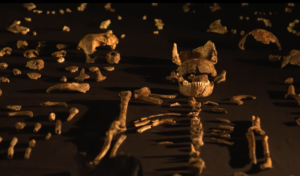Photos: YouTube Screenshots\Wikimedia Commons
An extinct human species that lived hundreds of thousands of years ago may have deliberately buried its dead and carved meaningful symbols deep in a South African cave—advanced behaviors generally deemed unique to Neanderthals and modern Homo sapiens. If confirmed, the burials would be the earliest yet known by at least 100,000 years.
The claims, made today in two research papers uploaded to the preprint server bioRxiv, were also announced by paleoanthropologist Lee Berger at a conference at Stony Brook University in New York.
The publications come eight years after Berger first reported the discovery of a new hominin species inside the Rising Star cave system 25 miles northwest of Johannesburg. Named Homo naledi, the species is characterized by its small size—including a brain roughly a third the size of today’s humans—and a baffling mix of very old and relatively modern anatomical features.
The skeletal remains discovered in the cave are concentrated in a single, hard-to-reach subsystem and are dated to between 335,000 and 241,000 years ago—a period when modern humans were just beginning to emerge in Africa.
“We’ve found the cultural space of a non-[modern] human species,” Berger says. The research is sponsored by the National Geographic Society, where Berger is explorer-in-residence.
Berger’s team raised the possibility of intentional burials in 2015 when it first announced the discovery of Homo naledi. That seemed the most plausible explanation for how more than 1,800 bone fragments ended up deep in an underground chamber reachable only by a four-story vertical drop through a 7.5-inch-wide slot—the length of a pencil—they dubbed the Chute.
Moreover, the position and intactness of some skeletal remains suggested that the dead may have been carefully laid out on the floor of the chamber rather than tossed down the Chute to collect as a jumble of bones at its base.
Many experts were skeptical that a small-brained hominin could engage in such human-like behavior, suggesting instead that the remains washed into the cave or were carried inside by predators. But the bone fragments showed no traces of gnaw marks, and analysis of the cave environment and sediments ruled out water deposition.
Other skeptics suggested that modern humans, who likely overlapped with Homo naledi in southern Africa for at least 50,000 years, may have carried the bodies in through the Chute or some other passage that has since collapsed. But the Rising Star team found no signs of modern humans and no evidence of a secondary entrance.
The researchers returned to Rising Star in 2017 and began making a series of discoveries that have not been fully revealed until now. They include concentrations of Homo naledi bone fragments that may belong to one or more individuals in shallow pits that cut through the layers of the cave floor and don’t follow its natural slope—evidence suggesting that the pits were dug.















